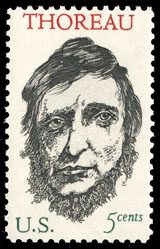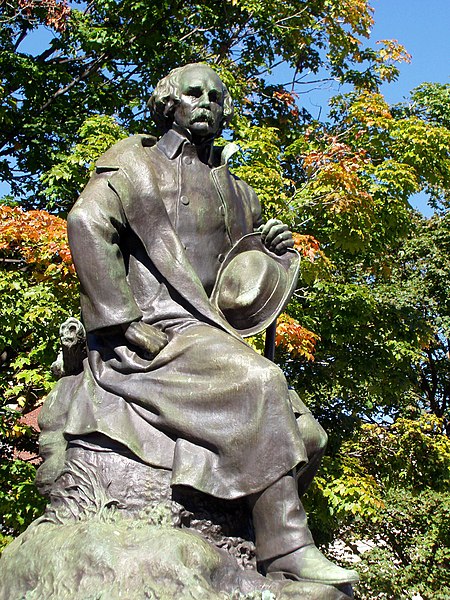The Concord Boys: Not, surprisingly, an adolescent crime-fighting team travelling around in an old jalopy.
Welcome back to the Cabinet, friends, acquaintances, enemies, and unknowns.
Perhaps you've been forced to read The Scarlett Letter in high school English. Maybe you've been subjected to that tired old advice, "Hitch your wagon to a star," even though you haven't seen any non-Anabaptists driving a wagon in fifty years! Or perchance you've pretentiously driven out to the woods (in your horseless carriage) to read from Walden in the hopes of gaining some white-liberal-guilt insight. I known I have! Well, who were these Hawthornes, Emersons, and Thoreaus you're always hearing about? Why do these Puritan descendants bestride our American literary tradition like transcendental colossi? Well, if you're looking for answers, I'm afraid I can't help you. I merely write a pseudofactual web log for the entertainment of my loyal reader(s).
Massholes Gone Postal: All three Concordians (Concordese? Concordites?) eventually were immortalized on United States postage stamps. I'm thinking that, once again, Thoreau got the short end of the deal.
But I digress. All three of these gents lived in one small town outside of Boston, Mass., where grape vines grew wild in the streets. What are the odds? And they often lived in the same houses! My guess is that, because of town historic zoning laws, Concord only had three habitable dwellings (Emerson's house, the Old Manse, and Thoreau's Cabin) for much of the nineteenth century. But let us look more closely at these New England literary lights, the bane of high school students everywhere. They were all of good Massachusetts Yankee stock. Ralph Waldo Emerson (1803-1882), Nathaniel Ha(w)thorne (1804-1864), and Henry David Thoreau (1817-1862) were born in Boston, Salem, and Concord, respectively.
A Reminder of 19th-Century Standards of Personal Space: The assembled American nouveau-riche literati, including Emerson and Hawthorne, at the home of celebrated New Netherland author Diedrich "Washington Irving" Knickerbocker, c. 1855. Thoreau, ever the obstinate Luddite, refused to have himself engraved by what he called the "evil engraving partnership" of Nathaniel Currier and John Merritt Ives.
Emerson, the oldest and most famous in his lifetime, was an ordained Congregationalist minister, but the clergy didn't really pan out. It was he that coined the term "Transcendentalist," after a long night of hard drinking at the Wayside Inn with pal H. W. Longfellow. Emerson moved to Concord and took up residence with his family in a sprawling New England farmhouse. Thoreau (an estate handyman, like on Newhart!) lived there for a time, among other notables. Strangely, Emerson and his succession of wives refused to do any of the housework for themselves (which was not that unusual in itself), but would not hire any servants to do so. They insisted on sharing their house with a married couple of "caretakers" that preserved each room in a pristine state. All this from a man whose most famous essay is called "Self-Reliance" -- the nerve!
My guess is that you are probably most familiar with Concord, Mass. as the birthplace of the American pencil industry. Well, pencilophiles take heart! One of our Concord Boys was involved intimately in the graphite-trade. That's right, Thoreau's family owned the John Thoreau & Co. Dam-Powered Pencil Works. H.D.T. worked at factory for much of his adult life, churning out the firm's patented graphite-clay composite (which he invented) writing tools for the benefit of "quietly desperate" schoolchildren and carpenters in greater New England. Although often thought of as an environmentalist, Thoreau also accidently set fire, when hanging out with a friend, to three hundred acres of woods around Walden Pond, the timber equivalent of 2,300 lakeside cabins, or $64,687 (over $2 million today!). Well, maybe it wasn't such a big deal for nineteenth-century writers to set forest fires, as the case of Samuel and Orion Clemens demonstrates.
Hawthorne was a different kind of fellow altogether, although he lived for a short while at the infamous utopian Brook Farm experiment. He worked, for a period, at the Salem Customs House, inspiring his most famous work, A Complete Guide to the Rules, Regulations, and Required Forms of the Salem, Massachusetts Customs House. Hawthorne attended Bowdoin College, in Mainechusetts, and became lifelong friends and future no-name president Franklin "We Polked you in '45" Pierce and tavern proprietor H. W. Longfellow and was, in his words, "an idle student, negligent of college rules." He was great buddies with Emerson and Thoreau, but he preferred his study in his seven-gabled Manse to the Emersons' porch.
Cast for the Ages: In a morally questionable move by the overzealous Concord city council, the bodies of Thoreau, Emerson, and Hawthorne were encased in marble after their deaths in what was arguably an elaboration on the Victorian enthusiasm for the death mask. Sadly, because he died from a pencil lathe accident, only Thoreau's upper torso and head were preserved.
Well, maybe you've learned a few inane facts about this triumvirate of Concordites. (I've settled on that.) Until next time, when we thankfully return to friendly confines of the early modern period, this is the Cabinet signing off.











No comments:
Post a Comment